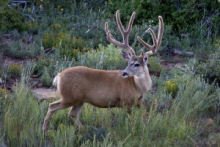Article
Because of its prevalence throughout the Southwest, Hillerman is probably referring to the mule deer, named for its ears, which are large like those of the mule. There are several additional subspecies of deer, including the black-tailed deer. Unlike the related white-tailed deer, mule deer are generally more associated with the land west of the Missouri River, and more specifically still with the Rocky Mountain region of North America.
"Ten-point mule deer buck" by woodleywonderworks is licensed under CC BY.
Manuscripts
A04 Dance Hall of the Dead (02-04) p. 36
A04 Dance Hall of the Dead (02-04) p. 43
A04 Dance Hall of the Dead (02-04) p. 45
A04 Dance Hall of the Dead (02-04) p. 46
A04 Dance Hall of the Dead (02-04) p. 50
A04 Dance Hall of the Dead (02-04) p. 64
A04 Dance Hall of the Dead (02-04) p. 65
A04 Dance Hall of the Dead (02-04) p. 66
A04 Dance Hall of the Dead (02-04) p. 88
A04 Dance Hall of the Dead (02-04) p. 90
A04 Dance Hall of the Dead (02-04) p. 91
A04 Dance Hall of the Dead (02-04) p. 93
A04 Dance Hall of the Dead (02-04) p. 94
A04 Dance Hall of the Dead (02-04) p. 96
A04 Dance Hall of the Dead (02-04) p. 103
A04 Dance Hall of the Dead (02-04) p. 1044
A04 Dance Hall of the Dead (02-04) p. 105
A04 Dance Hall of the Dead (02-04) p. 106
A04 Dance Hall of the Dead (02-04) p. 111
A04 Dance Hall of the Dead (02-04) p. 121
References
Jim Heffelfinger
2006 Deer of the Southwest: A Complete Guide to the Natural History, Biology, and
Management of Southwestern Mule Deer and White-tailed Deer. College Station: Texas A
& M University Press.

